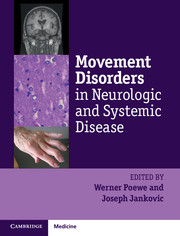Book contents
- Frontmatter
- Contents
- List of contributors
- List of videos
- List of abbreviations
- Preface
- Section I General principles
- Section II Movement disorders in systemic disease
- Section III Iatrogenic and toxic movement disorders
- Chapter 14 Drug-induced movement disorders
- Chapter 15 Movement disorders associated with chronic metal poisoning
- Chapter 16 Movement disorders following non-metal intoxications
- Section IV Movement disorders in general neurology
- Section V Systemic complications of movement disorders
- Index
- Plate Section
- References
Chapter 14 - Drug-induced movement disorders
from Section III - Iatrogenic and toxic movement disorders
Published online by Cambridge University Press: 05 April 2014
- Frontmatter
- Contents
- List of contributors
- List of videos
- List of abbreviations
- Preface
- Section I General principles
- Section II Movement disorders in systemic disease
- Section III Iatrogenic and toxic movement disorders
- Chapter 14 Drug-induced movement disorders
- Chapter 15 Movement disorders associated with chronic metal poisoning
- Chapter 16 Movement disorders following non-metal intoxications
- Section IV Movement disorders in general neurology
- Section V Systemic complications of movement disorders
- Index
- Plate Section
- References
Summary
Movement disorders attributable to prescribed medications and drugs of abuse are commonly encountered in the clinic. This chapter will review the wide variety of movement disorders due to dopamine-receptor blocking agents (DBAs), other medications, and the drugs of abuse.
Movement disorders due to DBAs
Antipsychotic agents, also termed neuroleptics or dopamine-receptor blocking agents (DBAs), are extensively utilized in the management of psychiatric disorders such as schizophrenia and bipolar disorders, and DBAs are employed in the treatment of neurological diseases such as Tourette’s syndrome, Huntington’s disease, psychosis in Parkinson’s disease, and dementias such as dementia with Lewy bodies. In addition, metoclopramide (MCP) is widely used to treat gastrointestinal motility disorders. The introduction of chlorpromazine in the early 1950s was nothing short of a miracle in the treatment of psychosis, but it was soon realized that there were significant neurological side effects associated with this class of drugs. Extrapyramidal side effects (EPS) was an umbrella term used to describe these side effects. Initially, it was thought that the induction of EPS was integral to the clinical antipsychotic efficacy of chlorpromazine and a dopamine depleter reserpine. More recently with the advent of clozapine, this tight linkage between EPS and antipsychotic efficacy has been shown to be fallacious. The evidence implicates the degree of D2 receptor antagonism and the speed of dissociation in the development of these EPS (DBAs with less D2 affinity and more rapid dissociation are less likely to produce EPS). In addition, the blockage of other neurotransmitter receptors such as 5-hydroxytryptamine (5-HT2) receptors may be important, allowing the development of drugs that are less likely to cause movement disorders.
- Type
- Chapter
- Information
- Movement Disorders in Neurologic and Systemic Disease , pp. 203 - 219Publisher: Cambridge University PressPrint publication year: 2014



